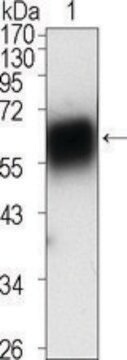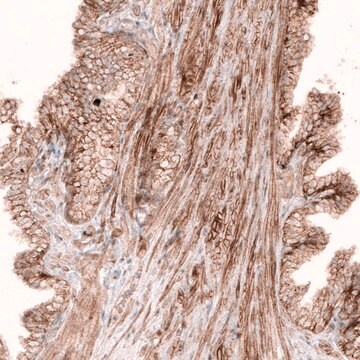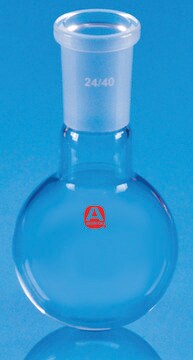MABS1152
Anti-ROR2 Antibody, clone Nt 2535-2835
clone Nt2535-2835, from mouse
Synonym(e):
Tyrosine-protein kinase transmembrane receptor ROR2, mRor2, Ntrkr2, Neurotrophic tyrosine kinase receptor-related 2
About This Item
Empfohlene Produkte
Biologische Quelle
mouse
Qualitätsniveau
Antikörperform
purified immunoglobulin
Antikörper-Produkttyp
primary antibodies
Klon
Nt2535-2835, monoclonal
Speziesreaktivität
mouse, human
Methode(n)
ELISA: suitable
immunohistochemistry (formalin-fixed, paraffin-embedded sections): suitable
western blot: suitable
Isotyp
IgG1κ
UniProt-Hinterlegungsnummer
Versandbedingung
wet ice
Posttranslationale Modifikation Target
unmodified
Angaben zum Gen
human ... ROR2(4920)
Allgemeine Beschreibung
Spezifität
Immunogen
Anwendung
Zelluläre Signaltransduktion
Kinasen & Phosphatasen
Immunohistochemistry Analysis: A representative lot detected Ror2 expression in various regions of wild-type and Ror2+/-, but not Ror2-/-, mouse E13.5 embryos by both fluorescent and non-fluorescent immunohistochemistry using paraformaldehyde-fixed, paraffin-embedded whole mount sections (Mikels, A., et al. (2009). J. Biol. Chem. 284(44):30167-30176).
Immunohistochemistry Analysis: A representative lot detected Ror2 expression in the dermis of wild-type, but not Ror2-knockout mouse skin from E16.5 mouse embryos using paraformaldehyde-fixed, paraffin-embedded whole mount sections (van Amerongen, R., et al. (2012). Dev. Biol. 369(1):101-114).
Western Blotting Analysis: A representative lot detected full-length murine Ror2, as well as Ror2 deletion constructs lacking the first Ser/Thr-rich domain (ST1; a.a 753-782) or the Pro-rich domain (a.a. 784-857), but not Ror2 deletion mutants lacking the ST2 (a.a. 859-882) domain (Mikels, A., et al. (2009). J. Biol. Chem. 284(44):30167-30176).
Enzyme-linked Immunoabsorbent Assay (ELISA): The immunoreactivity of a representative lot toward the immunogen MBP fusion protein was confirmed by ELISA (Mikels, A., et al. (2009). J. Biol. Chem. 284(44):30167-30176).
Qualität
Western Blotting Analysis: 0.5 µg/mL of this antibody detected ROR2 in 10 µg of MEF-1 cell lysate.
Zielbeschreibung
Physikalische Form
Lagerung und Haltbarkeit
Sonstige Hinweise
Haftungsausschluss
Sie haben nicht das passende Produkt gefunden?
Probieren Sie unser Produkt-Auswahlhilfe. aus.
Lagerklassenschlüssel
12 - Non Combustible Liquids
WGK
WGK 1
Flammpunkt (°F)
Not applicable
Flammpunkt (°C)
Not applicable
Analysenzertifikate (COA)
Suchen Sie nach Analysenzertifikate (COA), indem Sie die Lot-/Chargennummer des Produkts eingeben. Lot- und Chargennummern sind auf dem Produktetikett hinter den Wörtern ‘Lot’ oder ‘Batch’ (Lot oder Charge) zu finden.
Besitzen Sie dieses Produkt bereits?
In der Dokumentenbibliothek finden Sie die Dokumentation zu den Produkten, die Sie kürzlich erworben haben.
Unser Team von Wissenschaftlern verfügt über Erfahrung in allen Forschungsbereichen einschließlich Life Science, Materialwissenschaften, chemischer Synthese, Chromatographie, Analytik und vielen mehr..
Setzen Sie sich mit dem technischen Dienst in Verbindung.








